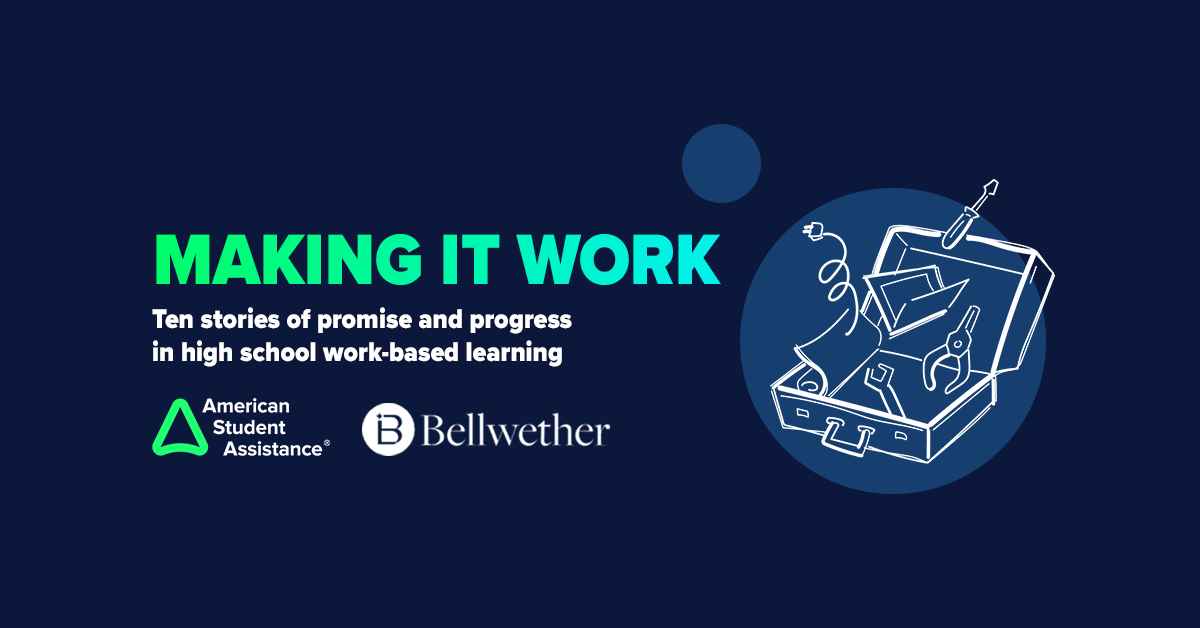When you think of “work-based learning” — that is, hands-on career education experiences like internships, apprenticeships, and job shadowing — what age group comes to mind?
Odds are, you’re thinking about college or perhaps even high school. But as ASA research shows, middle school is the prime time to begin engaging young people in career readiness learning before the “crunch time” effect of high school sets in, and student stressors and peer pressures reach new heights.
Kids in middle school are also just learning how to explore their own individual identities, which makes this time even more critical to get them thinking about potential education-to-career pathways.
This includes equitable access to work-based learning experiences.
On December 8, 2022, I was thrilled to host a virtual panel discussion alongside leaders from incredible organizations who have introduced innovative programs to pilot work-based learning opportunities for middle grades students: Letta Neely of Apprentice Learning; Pam Gordon of Big Picture Learning; and Tamera Marko of the Elma Lewis Center at Emerson College.
Here are my key takeaways from the conversation:
1. An ultimate end goal of work-based learning is “empowered autonomy” — but it takes a village to get there.
As Letta from Apprentice Learning noted, work-based learning experiences for middle school students should focus on building community for each young person that passes through the doors. Curating relationships, she went on to explain, is essential to being career-ready. If we can introduce kids earlier on to caring adults who can guide them on their paths, this will eventually lead to a sense of “empowered autonomy” in which they feel confident in making their own decisions because of the support and validation they’ve received from the adults around them.
Tamera agreed, adding that in her experience at the Elma Lewis Center, which works with Apprentice Learning, the experiential and environmental components are most important. It’s about getting young people into environments in which they meet people face-to-face and learn in a hands-on working model, rather than just reading about what a particular career entails.
2. There is work to be done to shatter the notion that middle school is “too early” to introduce work-based learning.
Pam from Big Picture Learning asserted that middle school is an excellent time to engage kids in career-readiness education, including work-based learning: “You don’t only learn in the four walls of the school,” she said, emphasizing that the importance of students being able to get out of the building and explore in a hands-on environment can have palpable benefits on their overall engagement in the work they’re doing.
As Letta pointed out, so many middle-grades students, particularly in public schools in underserved communities, have become disenfranchised and disengaged. But work-based learning experiences provide these kids a sense of purpose and belonging that tells them I’m worthy of trying this.
When you begin introducing these experiences to young people in middle school, they act as a portal to what’s possible.
3. The future of work-based learning for middle school students will require a hybrid approach of in-person learning and technology solutions, driven by new platforms and structural innovations.
Pam spoke about how Big Picture Learning is revolutionizing internships in K-12 with its platform ImBlaze, which pairs students with curated internship opportunities that are then monitored by schools to track attendance and ensure compliance as well as student success. The platform, she said, has proven to be a great way for young people to gain experience and build social capital sooner in their journeys.
Additionally, BPL’s newest platform, B-Unbound, builds on the success of ImBlaze – but focuses on opportunities outside of the school environment, to allow young people to build peer communities as well as establish relationships with caring adults in fields they’re interested in pursuing.
Apprentice Learning is one organization that has utilized BPL’s offerings. Letta explained that the technology has helped the organization streamline its processes.
She then expanded on Apprentice Learning’s structure, which begins with Workplace Explorations. This is when students go to visit businesses to see what opportunities are available there, and learn basic skills like hand-shaking and eye contact. This is followed by the City Summer Internship, in which students who graduate eighth grade are able to participate in hands-on career learning with employer partners. This is especially important for female-identifying youth, as it opens doors to careers that they may not have thought were accessible to them.
4. Facilitating work-based learning for middle school students requires buy-in from employers who are willing to provide these experiences. (And it can be a tough sell.)
In order to get employers on board to help middle school students gain experience, they first have to be given proper insight into what value it might bring to their organization — and establish relationships built on trust.
For Tamera, who has brought in middle school students to intern at the Elma Lewis Center, it starts with one fundamental idea: seeing people as portals.
“It shouldn’t be that we have business over here and school over there. As people, eighth graders included, we are portals to what we can build together,” she explained.
In order to realize this vision, the Elma Lewis Center partnered with Apprentice Learning who provided an “employer orientation” to educate them on the value of working with middle schoolers and the unique perspective and opportunity they bring to the table.
Pam added that at BPL, they encourage students to “cold-call” employers with a prepared elevator pitch as well as questions about the organization or industry — which often leads to the employer being impressed and wanting to know more about providing work-based learning experiences to kids in this age group.
Similarly, Apprentice Learning focuses on helping students look for opportunities in their communities. If they see a company while out for a walk, online, or in the paper that the students find interesting, they might call up that organization to explore potential experiences and partnerships. These relationships typically start with one person “who thinks young people are already amazing” and can then introduce them to a broader network of support.
Thank you for reading! I’d love to hear your thoughts on middle school work-based learning; what do you think is the best way to engage kids in WBL at this age?
You can watch the full panel discussion here.
For more on the latest trends and insights in career readiness learning, subscribe to ASA’s newsletter, PivotED.




